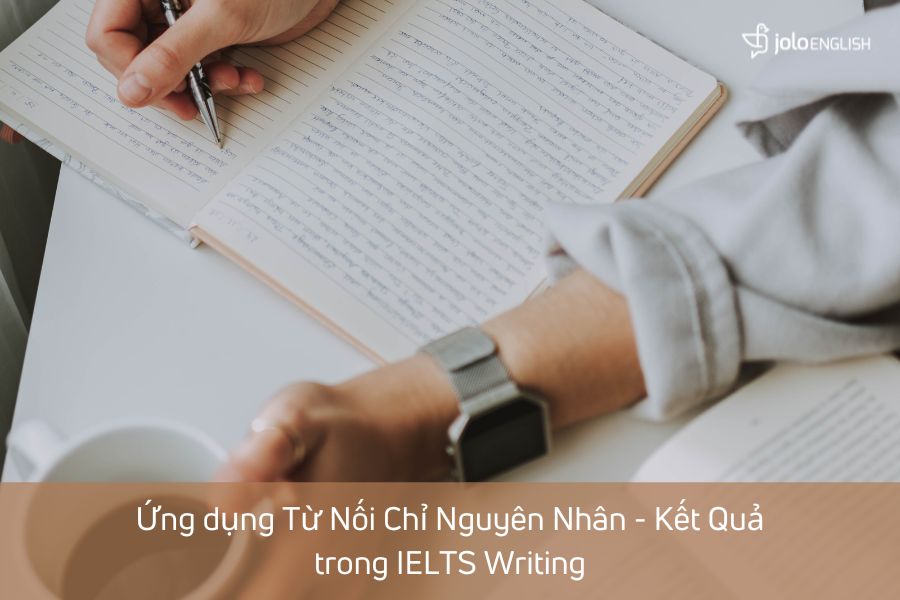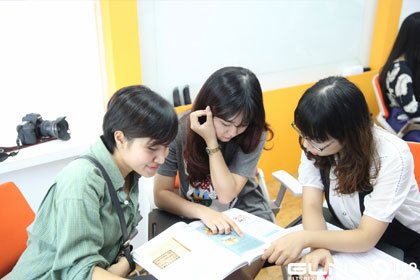Từ nối (linking words) là một trong những yếu tố quan trọng để viết được một bài viết học thuật hiệu quả vì việc sử dụng các từ nối phù hợp giúp đáp ứng tiêu chí Coherence & Cohesion trong IELTS Writing. Bài viết hôm nay, JOLO sẽ giới thiệu nhóm từ nối chỉ nguyên nhân – kết quả thường được sử dụng; kèm theo ví dụ và cách vận dụng nhóm từ nối chỉ nguyên nhân - kết quả vào IELTS Writing nhé!

Giới thiệu về các từ nối chỉ quan hệ nguyên nhân - kết quả
Từ nối chỉ nguyên nhân - kết quả (Causal Transition Words) là một tập hợp những từ nối nhằm để liên kết hai câu hoặc hai mệnh đề trở lên, được sử dụng với vai trò giải thích lý do giữa các vế, luận điểm trong đoạn văn.
Từ nối chỉ quan hệ nguyên nhân - kết quả được chia thành 5 dạng chính thường gặp với 5 chức năng khác nhau, bao gồm:
- Showing Cause or Reason: Biểu thị nguyên nhân hoặc lý do
- Explaining the Conditions: Giải thích về các điều kiện
- Showing the Effects/ Results: Biểu thị các kết quả, hệ quả
- Showing the Purpose: Thể hiện mục đích
- Highlighting the Importance of Circumstances: Nhấn mạnh tầm quan trọng của hoàn cảnh (ngữ cảnh)
Tổng hợp các các từ nối chỉ quan hệ nguyên nhân - kết quả
1. Because/As/Since
“Because/As/ Since” đều có nghĩa là “bởi vì”, “tại vì” và thường nằm ở vị trí đầu câu hoặc giữa câu, bắt đầu cho một mệnh đề nằm sau mệnh đề chính phía trước.
Mẫu cấu trúc:
- Because/As/Since + clause 1 (nguyên nhân), clause 2 (kết quả)
- Clause 1 (kết quả), because/as/since + clause 2 (nguyên nhân)
Ví dụ:
- Because/As/Since private vehicles are creating a great number of exhaust fumes, air pollution becomes more serious.
- He never eats meat, because/as/since he is a vegetarian.
2. Because of/Due to/Owing to
“Because of/Due to/ Owing to” đều có nghĩa là “bởi vì”, “do đó”. Cụm này thường được thêm vào trước một danh từ/cụm danh từ/danh động từ để thể hiện rằng sự vật/hiện tượng được nhắc đến trong mệnh đề trước là nguyên nhân của mệnh đề theo sau.
Mẫu cấu trúc:
- Because of/Owing to/Due to + Noun/Noun phrase, clause.
- Because of/Owing to/Due to + V-ing, clause. (chỉ dùng khi chủ ngữ (ẩn) của V-ing và chủ ngữ trong clause giống nhau)
Ví dụ:
- Because of/Due to/Owing to the bad weather, the match was cancelled.
- Because of/Owing to/ Due to feeling very tired, he couldn’t sleep.
3. Hence/Thus,
“Hence/Thus” có nghĩa là “do đó”, "vì vậy", có thể đứng đầu câu hoặc ở giữa câu để ngăn cách hai mệnh đề để chỉ nguyên nhân, hệ quả của sự vật, hiện tượng được nhắc đến. “Hence/Thus” thường được ngăn cách với phần còn lại của câu bằng dấu phẩy.
Mẫu cấu trúc:
- Hence/Thus, clause
- Clause 1; hence/thus, + clause 2
- Clause, hence/thus + noun/noun phrase
Ví dụ:
- Universities provide students with good chances of career paths. Hence/Thus, many people go to universities.
- Universities provide students with good chances of career paths; hence/thus, many people go to universities.
- She’s just failed her exam, hence/thus her bad mood.
4. Therefore/ Consequently
“Therefore/ Consequently” có nghĩa là “vì vậy”, “hệ quả là”, được sử dụng để đưa ra kết quả cuối cùng sau khi trình bày luận điểm ở phía trước.
Mẫu cấu trúc:
- Therefore/Consequently, + clause
- Clause 1; therefore/consequently + clause 2
- Clause and therefore/consequently + Verb/Adjective
Ví dụ:
- Universities provide students with good chances of career paths. Therefore/Consequently, many people go to universities.
- Universities provide students with good chances of career paths; therefore/consequently, many people go to universities.
- People are born with different talents and therefore/consequently follow different career paths.
5. So
Mẫu cấu trúc:
- Clause 1, so + clause 2
- So, clause (chỉ sử dụng trong Speaking)
Ví dụ:
- Many people work hard to earn a living, so they barely have time for their family.
- Universities are normally expensive in my country. So, not everyone can afford it.
6. Thus/ Thereby
Mẫu cấu trúc:
- Clause, thus/thereby + V_ing
- Clause and thus/thereby + V
Ví dụ:
- He failed the test, thus/thereby failing the course.
- He failed the test and thus/thereby failed the course.
Cách ứng dụng của từ nối chỉ quan hệ nguyên nhân - kết quả trong IELTS Writing Task 2
Trước hết hãy cùng JOLO tìm hiểu đề thi và bài mẫu dưới đây:
Question: Today more people are travelling than ever before. Why is this the case? What are the benefits of travelling for the traveller?
Give reasons for your answer and include any relevant examples from your own knowledge or experience.
Answer:
It is believed that the travelling rate of people today is higher than ever. The following essay will discuss some of the factors which affect the situation and several advantages of the activity for the traveller.
There are various reasons why the travelling activities have increased significantly in the past recent years. Firstly, a lot of people travel intensively due to the existence of low-cost airlines. It is a fact that budget airline companies such as Air Asia or TigerAir are providing an affordable and economic ticket, therefore, people from a different range of income could purchase it. Secondly, many companies have increased their export and import activities due to globalization. As a result, their employees have to do excessive business trips to other regions or other continents. Thirdly, as business competition gets tougher each day, the stress level of the workers has risen. Consequently, the number of people who travel for leisure activities has grown rapidly in the past few years.
It is undeniable that travelling activities bring a lot of benefits for the travellers themselves. As people travel to another country, they would have the chance to learn a new culture. For example, many westerners have visited China, since they were attracted to see the unique culture of the ancient China civilisation such as the Great Wall of China or the Terracotta Army. Travelling also helps people in releasing their stress. It is obvious that people who live in big cities are stressed with their tight schedule and by taking some trips to the countryside; it will help them in loosening the tension.
In conclusion, it is true that travelling activities have increased rapidly in the past recent time, and people are travelling for various kinds of purposes. Some people are taking the trips for business activities, while others are for holiday. Travelling is also a positive activity since people could get a lot of benefits from doing the activity.
Qua bài mẫu trên, có thể thấy những từ nối chỉ nguyên nhân - kết quả thường được sử dụng ở cuối các luận điểm, với mục đích là đưa ra kết luận:
- As a result, their employees have to do excessive business trips to other regions or other continents. Thirdly, as business competition gets tougher each day, the stress level of the workers has risen.
- Consequently, the number of people who travel for leisure activities has grown rapidly in the past few years.
Hay nhóm từ nối chỉ nguyên nhân - kết quả cũng thường được sử dụng hầu hết các phần kết của một đoạn văn, với mục đích là đưa ra kết luận cho những câu văn trước đó.
Hi vọng với bài viết này, JOLO đã giúp bạn nắm được cách sử dụng từ nối chỉ quan hệ nguyên nhân - kết quả cũng như vận dụng nhuần nhuyễn chúng vào bài thi IELTS Writing của mình. Chúc bạn thành công trong công cuộc chinh phục IELTS!
Nếu bạn muốn nâng cao các kỹ năng cần thiết trong bài thi IELTS nhưng chưa biết bắt đầu từ đâu, đừng quên tham khảo các khóa học tại JOLO English tại đây nhé!
--------------------------------------
Tìm hiểu thêm các khóa học tại JOLO English - Hệ thống trung tâm dạy Tiếng Anh uy tín nhất tại Hà Nội và HCM :
- Khóa học Luyện Thi IELTS tại Hà Nội và HCM
- Khóa học Tiếng Anh Giao Tiếp tại Hà Nội và HCM
- Khóa học Tiếng Anh cho trẻ em
Hệ Thống Trung Tâm Anh Ngữ JOLO:
- Hà Nội: 093 618 7791
- TP. HCM: (028) 7301 5555
- JOLO: Số 4, ngõ 54 Nguyễn Thị Định, Q. Cầu Giấy, Hà Nội
- JOLO: Số 27 Trần Đại Nghĩa, Q. Hai Bà Trưng, Hà Nội
- JOLO: Số 67 Thụy Khuê, Q. Tây Hồ, Hà Nội
- JOLO: S4.01 Vinhomes Smart City, Q. Nam Từ Liêm, Hà Nội
- JOLO: Số 7, đường số 2, Cư Xá Đô Thành, Q.3, Tp.HCM
- JOLO: Số 2, tầng 1, tòa C2, Vinhomes Central Park, Q. Bình Thạnh, TP.HCM
- JOLO: S3.020215, Vinhomes Grand Park, P. Long Thạnh Mỹ, TP. Thủ Đức, TP. HCM





















